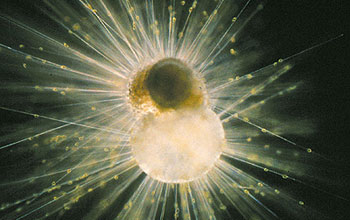
The geochemistry of microscopic plankton (foraminifera) was used to reconstruct ocean temperatures.
Credit and Larger Version
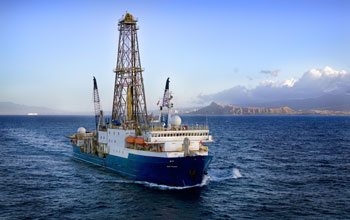
Scientists aboard the ocean drillship JOIDES Resolution retrieve deep-sea sediment cores.
Credit: IODP
Download the high-resolution JPG version of the image. (1.9 MB)
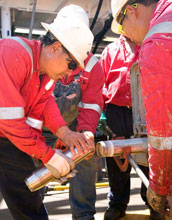
Aboard the JOIDES Resolution, crew members remove the core catcher from a core barrel.
Credit: IODP
Download the high-resolution JPG version of the image. (235 KB)
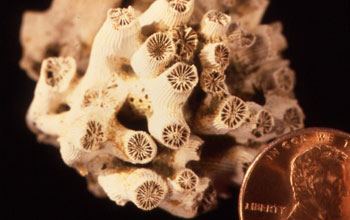
Former dwellers in Pliocene seas: fossil coral found on modern-day Cyprus.
Credit: Wikimedia Commons
| Download the high-resolution JPG version of the image. (473 KB) |
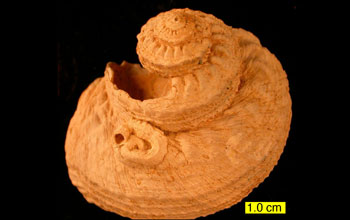
A fossil gastropod and attached tubeworm from the Pliocene, found on Cyprus.
Credit: Wikimedia Commons
Download the high-resolution JPG version of the image. (257 KB)
Temperature patterns during Earth's last prolonged global "hot
spell"--the Pliocene, some 5.3 to 2.6 million years ago--differed
dramatically from those of modern times, according to results reported
in this week's issue of the journal Nature.
Cloud
feedbacks, ocean mixing and other factors must have played a greater
role in Pliocene warming than previously recognized, and these must be
accounted for to make meaningful predictions of Earth's future climate,
the scientists said.
"This study shows that no one mechanism can
explain all the observations," says Candace Major, a program director in
the National Science Foundation's (NSF) Division of Ocean Sciences,
which funded the research.
The data come from studies of the
geochemistry of microfossils (microscopic shells of tiny plankton)
preserved in deep-sea sediments.
The sediments were retrieved by
researchers affiliated with the Deep Sea Drilling Project, the later
Ocean Drilling Program and the current Integrated Ocean Drilling
Program--all supported by NSF.
Yale University climate scientist
Alexey Fedorov and colleagues compiled records of sea surface
temperatures going back five million years, to the early Pliocene.
The
records reveal a world with fairly uniform warm temperatures in the
Tropics before four million years ago--a scenario that typical climate
model simulations fail to show.
"If we want to understand our
future climate, we have to be able to understand the climate of the
past," said Fedorov, an author of this week's paper.
"The
Pliocene Epoch attracts particular attention because of similar carbon
dioxide levels to what we have had over the last few decades, but its
climate was markedly different in several important ways," he said.
"If
we're able to simulate early Pliocene climate, however, we will be more
confident in our ability to predict future climate change."
Warm and temperate, the Pliocene is widely viewed as a potential analog for a future hot Earth.
Using
chemical fingerprints in ocean sediments to estimate sea surface
temperatures, the researchers describe long-term climate trends from the
early Pliocene to the present, comparing that ancient climate with
today's.
The Pliocene Earth had the same maximum temperature as
today, and a similar concentration of atmospheric carbon dioxide, but
waters in the Tropics--off the coast of Peru, for example--were much
warmer than they are now, resembling modern El Niño conditions.
There
was little to no east-to-west temperature variation along the equator.
Temperature differences between high latitudes and the Tropics were
also much smaller.
Kira Lawrence of Lafayette College, also an
author of the paper, said that "we have been focused on changes in the
global mean temperature. What our study demonstrates is the potential
for climate patterns to be markedly different in a world that is not
that much warmer than today's."
Previous attempts to explain Pliocene climate have emphasized tectonic changes in Indonesia and Central America.
But accounting for this in climate models still results in a conflict with actual temperature patterns.
The scientists have proposed several factors to explain warm temperatures during the Pliocene.
They
include ocean mixing in subtropical waters, perhaps due to widespread
hurricanes and diminished cloud reflectivity, maybe a result of a
different aerosol composition. Both would tend to warm the ocean.
When combined in models with higher levels of carbon dioxide, they help replicate conditions of the warm Pliocene Earth.
But so far these factors have not been included in climate models used to make future projections, the researchers said.
A
better understanding of what drove Pliocene climate, with its nearly
uniform tropical ocean temperatures, will increase our confidence in the
models, said Fedorov.
"We can't discount a possible future that
has a vast pool of warm water covering the tropics, and the changes in
atmospheric circulation and rainfall that would go along with that,"
said paper author Chris Brierley of the University College London.
Other
authors include Zhonghui Liu of the University of Hong Kong, Petra
Dekens of San Francisco State University and Christina Ravelo of
University of California, Santa Cruz.
In addition to NSF, the
research was supported by the U.S. Department of Energy, the David and
Lucile Packard Foundation and Yale University.
-NSF-
Media Contacts
Cheryl Dybas, NSF (703) 292-7734 cdybas@nsf.gov
Eric Gershon, Yale University (203) 432-8555 eric.gershon@yale.edu
Matthew Wright, Consortium for Ocean Leadership/IODP (202) 448-1254 mwright@oceanleadership.org
Eric Gershon, Yale University (203) 432-8555 eric.gershon@yale.edu
Matthew Wright, Consortium for Ocean Leadership/IODP (202) 448-1254 mwright@oceanleadership.org
Related WebsitesIntegrated Ocean Drilling Program: http://www.iodp.org
The National Science Foundation (NSF) is an independent federal
agency that supports fundamental research and education across all
fields of science and engineering. In fiscal year (FY) 2012, its budget
is $7.0 billion. NSF funds reach all 50 states through grants to nearly
2,000 colleges, universities and other institutions. Each year, NSF
receives over 50,000 competitive requests for funding, and makes about
11,000 new funding awards. NSF also awards nearly $420 million in
professional and service contracts yearly.
Useful NSF Web Sites:
NSF Home Page: http://www.nsf.gov
NSF News: http://www.nsf.gov/news/
For the News Media: http://www.nsf.gov/news/newsroom.jsp
Science and Engineering Statistics: http://www.nsf.gov/statistics/
Awards Searches: http://www.nsf.gov/awardsearch/
NSF Home Page: http://www.nsf.gov
NSF News: http://www.nsf.gov/news/
For the News Media: http://www.nsf.gov/news/newsroom.jsp
Science and Engineering Statistics: http://www.nsf.gov/statistics/
Awards Searches: http://www.nsf.gov/awardsearch/
The National Science Foundation (NSF)
Guillermo Gonzalo Sánchez Achutegui
ayabaca@gmail.com
ayabaca@hotmail.com
ayabaca@yahoo.com
Inscríbete en el Foro del blog y participa : A Vuelo De Un Quinde - El Foro!

No hay comentarios:
Publicar un comentario